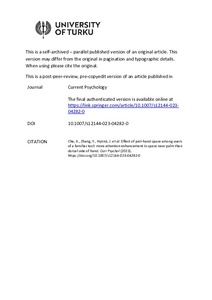Effect of peri-hand space among users of a familiar tool: more attention enhancement in space near palm than dorsal side of hand
Che Xiang; Zhang Yu; Hyönä Jukka; Lan Jijun; Li Jie
Effect of peri-hand space among users of a familiar tool: more attention enhancement in space near palm than dorsal side of hand
Che Xiang
Zhang Yu
Hyönä Jukka
Lan Jijun
Li Jie
SPRINGER
Julkaisun pysyvä osoite on:
https://urn.fi/URN:NBN:fi-fe2023031732174
https://urn.fi/URN:NBN:fi-fe2023031732174
Tiivistelmä
Peri-hand space (PHS) can be extended to space near tools used in everyday life, indicating that the space near the functional area of a tool acquires more spatial attention, which may be affected by tool experience. In previous studies, effects of extensive experience in tool use on the allocation of spatial attention near a tool have not been investigated. We aimed to remedy this by examining spatial attention allocation among table tennis athletes experienced in using a racket. Hands - the body parts that directly link the body and a tool - are vital for tool utilization; yet, few studies have explored whether holding a highly familiar tool in hand biases spatial attention toward it. Using an attentional cuing paradigm, we examined attention allocation in peri-hand space by comparing three hand-held conditions: table tennis racket, short brush and free hand. The performance of table tennis athletes was compared to that of badminton athletes and non-athletes. All three groups demonstrated attentional enhancement in PHS. More importantly, only table tennis athletes differentiated the space near the palm and dorsal side: attentional bias was greater for the palm side. We suggest that attentional enhancement at the palm side may be due to their frequent use of the forehand stroke. We further argue that as the functional area of the table tennis racket is very close to the hand, it is feasible that the attentional advantage related to the peri-hand space may be strengthened by extensive tool use.
Kokoelmat
- Rinnakkaistallenteet [27094]
